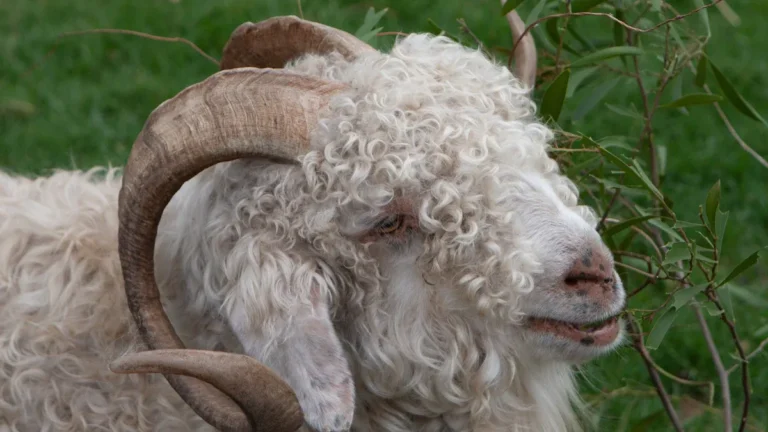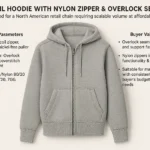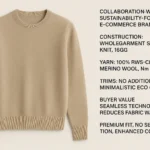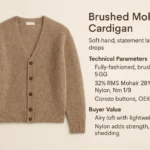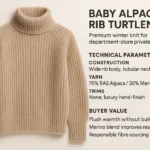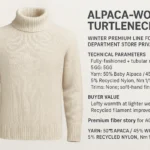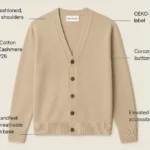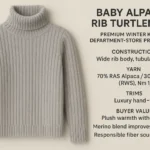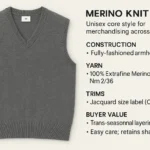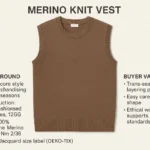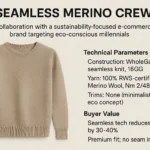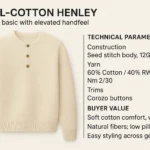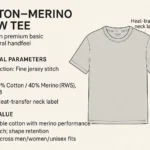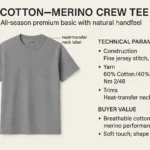
You can find scuba fabric in cool clothes and sports outfits, often referred to as Scuba Fabric 101. This man-made material mixes polyester and elastane, providing a smooth and slightly bouncy feel. Scuba fabric is crafted with a double-knit style, which makes it stretchy, strong, and bendy. Many clothes made from this material feel comfy and maintain their shape because of it. Designers appreciate scuba fabric because it retains its form and does not soak up water. Look at the table below to see how it is used in fashion:
Application Type | Description |
|---|---|
Sportswear | Scuba fabric stretches, allows air to flow, and feels comfy. People use it for leggings, tight tops, and sporty dresses. |
Outerwear | It is strong and keeps water out, making it ideal for jackets that block light rain. |
Dresses and Suits | Designers utilize scuba fabric for dresses, skirts, and suits, helping clothes look smooth and well-shaped. |
Key Takeaways
Scuba fabric mixes polyester and elastane. This makes it stretchy and strong. It is also comfortable for many clothing styles.
This fabric works well for sportswear and outerwear. It resists water and keeps its shape.
Scuba fabric is simple to care for. Wash it in cold water. Let it air dry. This helps it stay fresh and bright.
Designers like scuba fabric because it feels smooth. It does not wrinkle easily. It is great for fitted dresses and tailored tops.
Scuba fabric does not let air pass through. But it still feels comfy and gives good support. This makes it good for cooler weather.
Scuba Fabric 101 Overview
What Is Scuba Fabric
Scuba fabric is a modern material. It is made by mixing polyester and elastane. This mix makes the fabric smooth and a little bouncy. It feels soft when you touch it. Scuba fabric is lighter than neoprene. Both look alike, but scuba fabric is easier to wear.
People in the textile world talk about scuba fabric’s special build. It is made with a double-knit process. This helps the fabric stretch in every direction. It also keeps its shape well. Designers like scuba fabric because it is flexible and strong. It also looks neat and sharp. You can see how scuba fabric and neoprene are different in this table:
Feature | Scuba Fabric | Neoprene |
|---|---|---|
Composition | Polyester and spandex/elastane blend | Synthetic rubber |
Weight | Lightweight | Heavier |
Flexibility | More flexible | Less flexible |
Structure | Double-knit | Single-layer |
Applications | Fashion, activewear | Wetsuits, insulation |
Texture | Smooth, silky | Spongy, rubbery |
Stretch | 4-way stretch | Limited stretch |
Durability | High durability | High durability |
You can use scuba fabric for tight or loose clothes. The fabric is not see-through, so you do not need extra layers. It keeps its bright colors after many washes. When you learn about Scuba Fabric 101, you find a fabric that is comfy, stylish, and works well.
Key Features
Scuba fabric has many good points. These make it a favorite for fashion and sports clothes. Here are some top features:
It stretches in all directions, so you can move easily.
The fabric does not wrinkle or pill, so it stays neat.
It feels smooth and soft on your skin.
The double-knit style makes it strong and helps it keep its shape.
Scuba fabric is light, so you can wear it all day.
It keeps its bright colors, even after many washes.
The fabric is thick, so you do not need to wear more layers.
It keeps out water, so it is good for light jackets and sportswear.
Tip: Scuba fabric is great for dresses, skirts, and jackets. Its firmness helps these clothes keep their shape and look nice.
Lab tests show that scuba fabric can stretch and bend without damage. It also stands up to water and many chemicals. When you learn about Scuba Fabric 101, you see why many designers pick this fabric for cool, long-lasting clothes.
Origin and Evolution
Historical Background
Scuba fabric started with underwater exploration. In 1943, Jacques Cousteau and Émile Gagnan made the SCUBA system. This let divers bring their own air. Divers could stay underwater longer and go deeper. In the 1950s, neoprene wetsuits became popular. These suits were lighter than old canvas suits. Neoprene kept divers warm and made moving easier. Divers could swim better and stay warm in cold water.
Neoprene wetsuits helped divers stay underwater longer in cold places.
In 1952, Ted Eldred made scuba gear safer and more popular.
Neoprene wetsuits gave divers light, flexible, and warm protection.
Fashion designers saw how these materials helped shape clothes. They liked how neoprene and similar fabrics held their form. Over time, stretchy double-knit fabrics moved from diving suits to regular clothes.
Modern Development
Today, scuba fabric is used in many things. In the last twenty years, designers used it for more than sportswear. You can find it in everyday clothes, jackets, and home items. Scuba fabric stretches, lasts long, and does not wrinkle. Its smooth look and shine make clothes look new.
Scuba fabric is now in dresses, jackets, and home goods.
People like its stretch, strength, and wrinkle-free style.
Its shiny look makes it great for modern fashion.
You can wear scuba fabric in many ways. Its story goes from diving suits to fashion shows. When you wear it, you are part of a history of new ideas and style.
Composition and Manufacturing

Materials Used
Scuba fabric is made from a mix of materials. Most of it uses polyester and elastane together. This mix helps the fabric stretch and stay strong. The usual blend is about 95% polyester and about 5% elastane, but sometimes there is up to 10% elastane. Polyester helps the fabric stay strong and keeps its color bright. Elastane, also called spandex, lets the fabric stretch. When you wear scuba fabric, you feel comfortable and supported. The fabric moves with you and goes back to its shape after stretching.
The double-knit way of making it gives scuba fabric a smooth and soft feel. It feels gentle on your skin. The fabric can stretch in every direction and returns to its shape. This makes it great for sports clothes and tight outfits. Scuba fabric keeps its shape and color even after many washes.
Note: The right mix of polyester and elastane makes scuba fabric strong, stretchy, and comfy for daily use.
How It’s Made
You might wonder how scuba fabric gets its special look and feel. The answer is the double-knit process. This uses two sets of needles to knit two layers at once. The layers join together and make the fabric thick and steady.
Here are the main steps in making scuba fabric:
Chloroprene is made to start the process for synthetic fibers.
The chemicals turn into synthetic polymers like polyester.
Workers spin polyester and elastane into yarns and get them ready for knitting.
Machines use two sets of needles to knit the yarns into a double-layered fabric.
The fabric is dyed and finished to give it color and a smooth feel.
Workers check the fabric for quality and pack it for shipping.
The double-knit structure gives scuba fabric its special features:
The fabric is thicker and steadier than single-knit fabrics.
It lasts a long time and keeps its shape, so clothes look new.
The fabric stretches and goes back to its shape, so it fits well.
Scuba fabric feels smooth and spongy and looks neat.
Its thickness and steadiness help make dresses, skirts, and jackets look good.
When you learn about Scuba Fabric 101, you see how mixing polyester and elastane with the double-knit process makes a special fabric. You get comfort, style, and clothes that last a long time.
Properties, Pros, and Cons
Key Performance Properties
Scuba fabric is known for being stretchy, thick, and water-resistant. These features make it different from other fabrics. Experts use special tests to check how well it works:
Test Method | Description |
|---|---|
Hydrostatic Pressure Test | Measures how much water the fabric can block before it leaks. |
Spray Test | Checks if water rolls off the fabric when sprayed. |
You can stretch scuba fabric in every direction. This means you can move easily when you wear it. The double-knit design makes the fabric thick and helps clothes keep their shape. Scuba fabric also keeps water out, so it is good for jackets and sportswear.
Tip: Scuba fabric is a good pick if you want clothes that stay smooth and hold their shape.
Benefits
Scuba fabric has many good points for clothes and projects. Designers and makers like these main benefits:
Benefit | Description |
|---|---|
Structure and Stretch | Scuba fabric works well for fitted dresses and jackets that need to stretch and keep their shape. |
Wrinkle Resistance | It is easy to care for and does not wrinkle, so it is great for travel. |
Smooth Finish | The fabric looks smooth, which is nice for tight clothes that need to look neat. |
Scuba fabric keeps its color and shape after many washes. You can pack it in a bag, and it will not get wrinkled. The fabric feels soft and smooth, so you feel good wearing it all day. Some scuba fabric is made from recycled stuff, so it is better for the planet than some other fabrics.
Drawbacks
Scuba fabric is not perfect, and there are some things people do not like. Here are some common problems:
Drawback | Description |
|---|---|
High Cost | Neoprene can cost more than other fabrics. |
Limited Chemical Resistance | It does not protect well against some chemicals. |
Water Absorption | Even though Neoprene is waterproof, it can soak up water over time, so it is not good for electrical use. |
Non-breathable | Neoprene does not let air through, so it is not comfy for long wear. |
Environmental Impact | Making Neoprene is not good for the earth, and it does not break down. |
Scuba fabric can feel hot and does not let air pass through well. This can make it less comfy if you wear it for a long time in warm weather. Good scuba fabric can also cost more than other types. When you learn about Scuba Fabric 101, you see what makes it special and what its limits are.
Style Applications

Fashion and Apparel
Scuba fabric is used in lots of clothes today. Designers pick it for tight dresses, skirts, and sportswear. These clothes stretch and keep their shape well. Scuba fabric is good for surf clothes and sports bras. You also see it in office clothes like pencil skirts and fitted tops. The fabric lets you move easily and keeps its shape. Many designers like scuba fabric because it helps clothes look bold. Outfits made with it look smooth and fancy. Sewing with scuba fabric is simple because it does not slip.
Swaying skirts
Pencil skirts
Tailored tops
Surf apparel
Sports bras
Tip: Choose scuba fabric for clothes that need to stretch and look neat all day.
Accessories and Decor
Scuba fabric is found in many home and fashion accessories. People use it for pillows, blankets, and curtains. It is also used for napkins, placemats, tea towels, tablecloths, and table runners. The fabric keeps things dry and clean, which is great for outdoor parties. Scuba fabric is strong, so your items last a long time. It is easy to clean, so you can use it again and again.
Pillows
Blankets
Curtains
Tablecloths
Placemats
Tea towels
Table runners
Note: Scuba fabric is great for party decorations because it stays tidy and does not soak up spills.
Creative Uses
There are many fun and different ways to use scuba fabric. People make fitness gloves, socks, and comfy clothes with it. Factories use it for seat covers, safety gear, gaskets, and hoses. At home, you see it in cushion covers, drapes, and car seat covers. You also find it in things like knee sleeves, elbow braces, and sportswear.
Category | Examples |
|---|---|
Fashion | Fitness gloves, socks, casual wear |
Industrial | Seat covers, safety gear, gaskets, hoses |
Home & Decor | Cushion covers, drapes, car seat covers |
Consumer Goods | Knee sleeves, elbow braces, sportswear |
Scuba Fabric 101 shows how this fabric works for many things. Its stretch, shape holding, and water resistance make it a smart pick for clothes, accessories, and creative ideas.
Comparison and Care
Scuba Fabric vs Neoprene
You might wonder how scuba fabric compares to neoprene. Scuba fabric uses a blend of polyester and spandex. This makes it lighter and more flexible than neoprene, which is made from synthetic rubber. Neoprene feels heavier and thicker. Both fabrics are strong and resist water, but they serve different needs. You will find scuba fabric in fashion and light sportswear. Neoprene works best for wetsuits and tough sports because it keeps you warm and blocks water better.
Scuba fabric looks smooth and feels stretchy. It does not have the foamed rubber core that neoprene has. This means scuba fabric feels more comfortable and stylish, but it does not keep you as warm or dry in harsh conditions. Neoprene costs more because it insulates better and takes more work to make. Scuba fabric prices change based on quality and brand, but it usually costs less than neoprene.
Other Fabric Comparisons
You may also want to know how scuba fabric stands up to other double-knit fabrics like ponte and jersey. Here are some key points:
Scuba fabric is a double knit made from spun polyester and spandex. It feels smooth and springy.
It is thinner and more flexible than neoprene. You get better drape and shape.
Ponte and jersey have different stretch and durability. Ponte feels firmer, while jersey is softer and lighter.
Lycra has a tighter knit and more threads, making it very durable and elastic.
When you choose scuba fabric, you get a material that holds its shape and stretches well. It works for many styles and projects.
Care Tips
Taking care of scuba fabric helps your clothes last longer. If you use harsh detergents or wash in hot water, the fabric can fade and lose its shape. Always wash scuba fabric in cold water with mild soap. Air dry your items to keep them looking new. Avoid wringing or twisting the fabric. If you skip these steps, your clothes may wear out faster and look old.
Tip: Treat your scuba fabric gently. Good care keeps your favorite pieces looking fresh and stylish.
Scuba Fabric 101 shows you how to pick, compare, and care for this unique fabric. With the right care, your scuba fabric items will stay bright, stretchy, and comfortable.
Scuba fabric mixes polyester and spandex. This makes clothes stretchy and strong. It also feels comfortable when you wear it. You can use scuba fabric for dresses, jackets, and sports clothes. It keeps its shape and does not wrinkle easily. Some people wonder if scuba fabric is good for summer. It feels warm, so it is better for cooler weather. Here are some reasons to pick scuba fabric for your project:
Feature | Why It Matters |
|---|---|
Stretch and Comfort | Moves with you and fits well |
Durability | Lasts through many wears and washes |
Smooth Finish | Looks polished and modern |
You can use scuba fabric to make clothes that look bold and last a long time.
FAQ
Is scuba fabric comfortable to wear?
You feel comfortable wearing scuba fabric. The material stretches and moves with you. It feels soft and smooth against your skin. You can wear it for many hours without feeling restricted.
Can you wash scuba fabric in a washing machine?
You can wash scuba fabric in a washing machine. Use cold water and mild detergent. Air dry your items to keep them looking new. Avoid using bleach or wringing the fabric.
What types of clothing use scuba fabric?
You find scuba fabric in dresses, skirts, jackets, and sportswear. Designers use it for fitted tops and pencil skirts. The fabric works well for clothes that need to stretch and keep their shape.
Does scuba fabric cause sweating?
Scuba fabric does not breathe well. You may feel warm or sweat if you wear it in hot weather. Choose lighter clothes or wear scuba fabric during cooler days for more comfort.
Is scuba fabric eco-friendly?
Scuba fabric uses synthetic fibers. Most types are not biodegradable. Some brands use recycled polyester to help the environment. You can check labels to find eco-friendly options.






